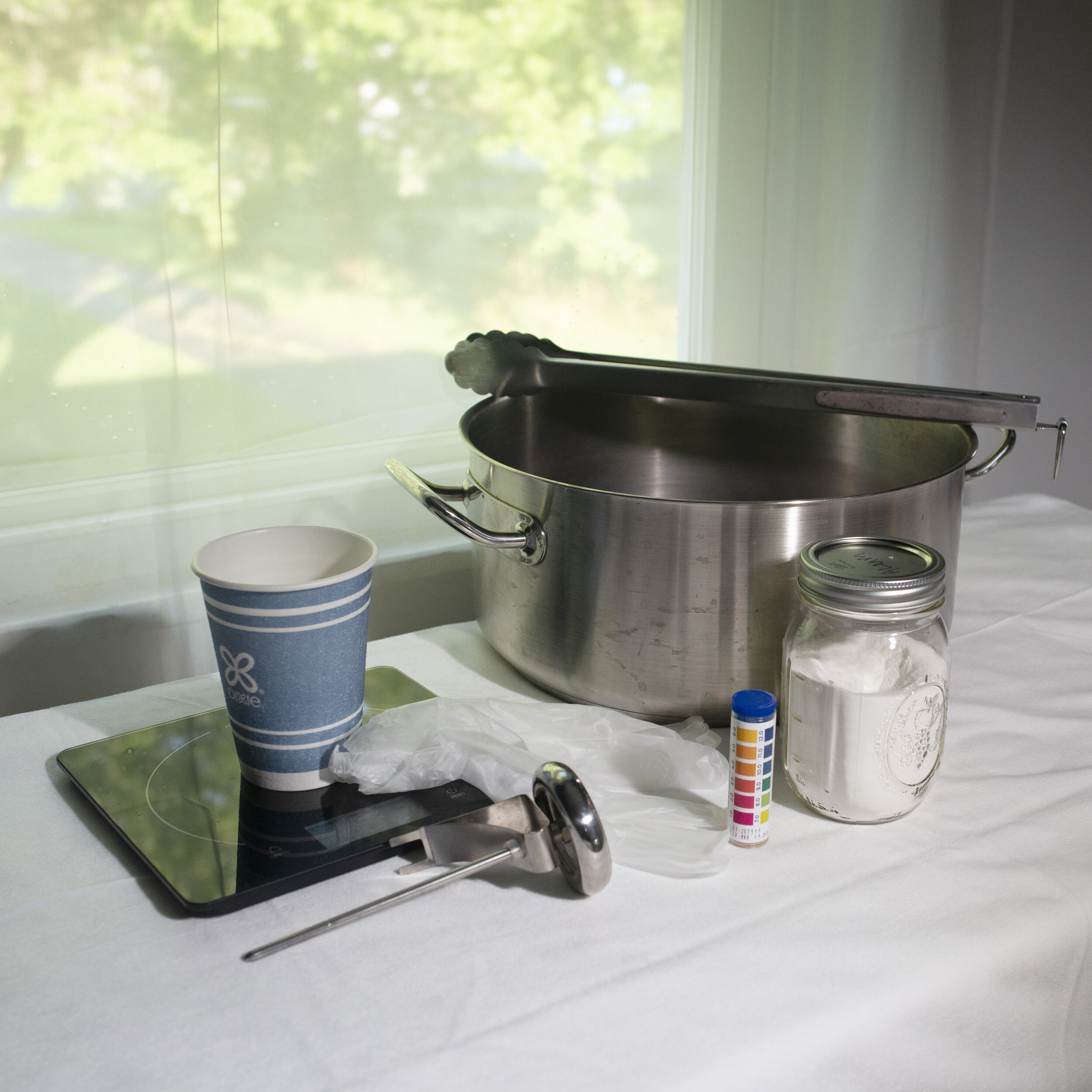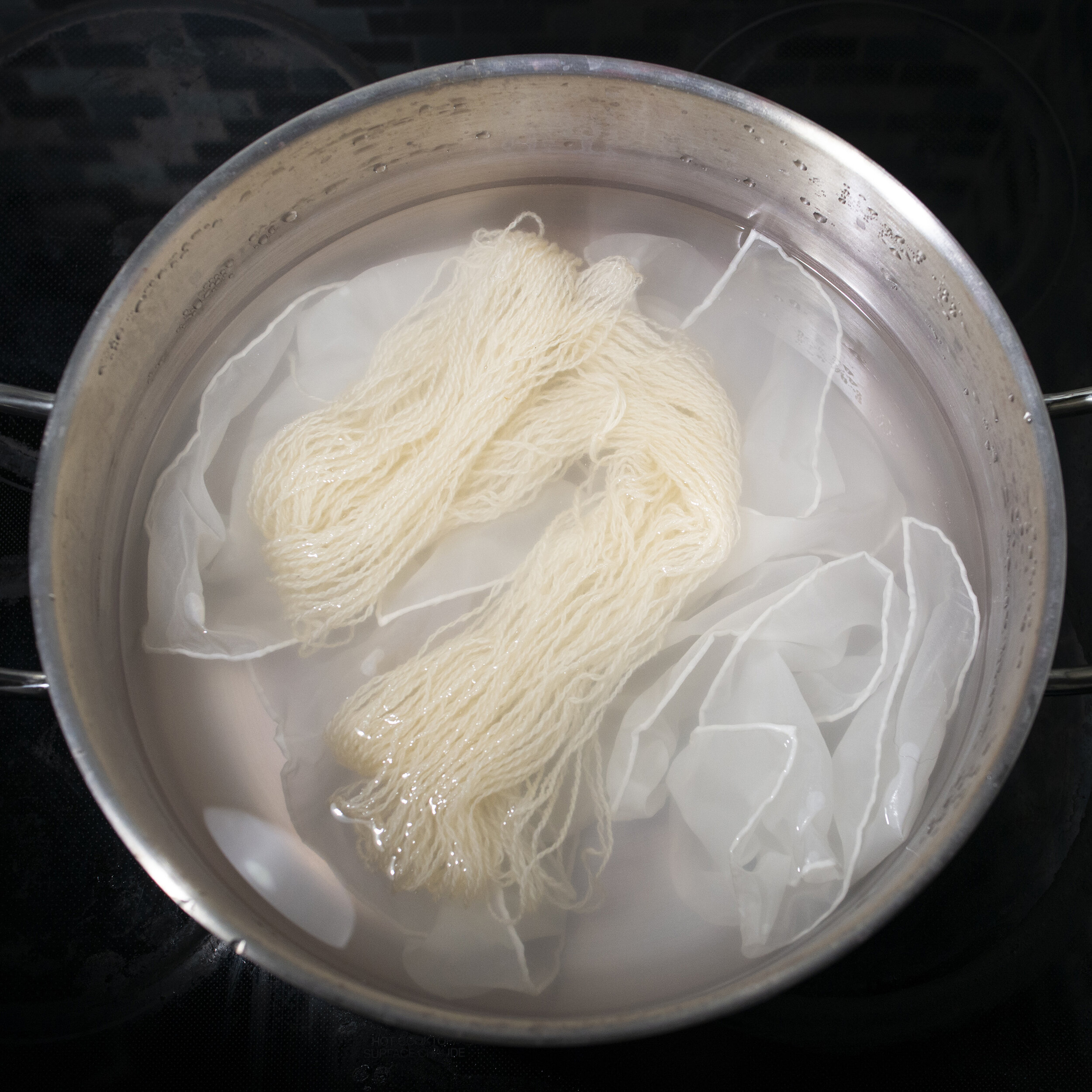
Lac Resin Extract
A Guide to Lac Resin Extract
Shepherd Textiles Lac Resin extract is made from the resin of a scale insect native to the forests of South Asia. Lac insects leave a waxy substance on branches that is known as shellac. It is collected and used as a varnish on wood instruments and furniture. Shellac naturally has a red tint, but the color can be extracted from the resin and concentrated into a deeply colored red powder. Lac Resin Extract gives strong reds with a purple hue reminiscent of merlot or burgundy; the color shifts to royal purple with an iron mordant. It is appropriate for all natural fibers, including cellulose fibers like cotton that are often difficult to dye. Product of India. Produced by a GOTS (Global Organic Textile Standard) certified manufacturer.
1. Background on Lac Resin
The Varnish Insect
Lac resin is produced by a scale insect, laccifer lacca or kerria lacca, that lives in the forests of South and Southeast Asia. As the insect crawls along a tree branch it punctures the bark to feed on the sucrose in the tree sap, and leaves behind a waxy substance known as shellac. Shellac is a natural polymer with many uses, principally as a wood varnish. It is soluble in alcohol and has good binding properties with wood, and creates a warm, glossy, waterproof finish. It is also edible, and is used to give a shiny exterior to apples and jelly beans.
Lac insects are distantly related to another important scale insect, cochineal, and lac dye performs similarly in a dye bath. It is strongly influenced by PH, and adding cream of tartar to the bath will both shift the color toward brick red and improve dye uptake. Similarly, alkaline modifiers will shift the color towards purple, and an iron mordant will yield steely mauve colors. Lac is a good choice for all natural fiber types, and its variability means that it will reward experimentation with different mordants and PH modifiers.
2. Safety Precautions
DO NOT INGEST. This extract was prepared for textile dyeing, not as an herbal supplement.
Avoid eye contact. If eye contact occurs, rinse with cool water.
Not for use as a cosmetic additive; do not apply directly to skin or hair.
Open carefully to avoid spilling or creating dust.
If a spill occurs, quickly wipe up with a paper towel or disposable rag.
Lac Resin Extract can permanently dye clothing, countertops, rugs, utensils, or other property. Avoid contact with anything that is not meant to be dyed.
Use only dye pots and utensils dedicated to dyeing. Do not use any pots, containers, spoons, tongs, thermometers, or other utensils that will be used for food preparation.
Lac Resin Extract, and all dye baths and mordant liquors made while dyeing, should be kept out of reach of children and pets. Use only with adult supervision.
Shepherd Textiles, LLC is not liable for any misuse of this product or any unintended staining of your clothing, workspace, or other property. Use only as directed.
3. Recommended Supplies
Dye pot. Use a dye pot large enough to hold all your fibers, with plenty of room for them to move around and for the liquid to circulate freely. Otherwise, particles of dye may get stuck on the fabric and cause dark splotches.
Metal tongs. A pair of tongs is useful for stirring and taking fabric out. Use tongs dedicated to dyeing, and not for food preparation.
Rubber gloves. Wear rubber gloves while handling extract powder and while handling mordanted/dyed fiber before it is rinsed.
Candy thermometer. The best way to keep track of temperature is to use a candy thermometer that clips to the side of the dye pot.
Scale. Use a scale to weigh out fiber, mordant, and extract powder.
Alum mordant. The alum usually used for mordanting is aluminum potassium sulfate, also known as potash alum. It is the same alum that you can find in a jar in the spice section at the grocery store.
Disposable cup. For mixing the extract powder to a paste.
4. Preparation: Mordanting with Alum
Lac Resin Extract bonds most effectively to fibers that have been mordanted with alum. For best results, soak your fibers in water for a few hours before mordanting, so that the mordant will penetrate deeply and evenly. Make sure to weigh the fibers first, while they are still dry.
Alum will dissolve quickly into hot tap water.
Heat fibers for an hour at 180F, then allow to cool.
For protein fibers (wool, silk, alpaca): Mordant at 12% WOF with alum.
Weigh out the fibers you plan to dye (while they are dry). Multiply that weight by 0.12 to get the amount of alum you will need.
Fill your dye pot with hot tap water, leaving enough room for the fiber.
Weigh out the correct amount of alum and pour it into the dye pot. Mix with a spoon or metal tongs until it has dissolved.
Gently place your fibers into the mordanting solution.
Heat mordant bath to 180F and maintain heat for 1 hour. If you don’t have a candy thermometer, you will have to estimate the temperature. At 180F, steam vapor will be rising off the water but it will not be bubbling. If your mordant bath starts to bubble, turn down the heat.
Stir every 15 or 20 minutes to make sure fibers mordant evenly. If they do not, the dye will take better in some places than others.
After an hour, remove from heat and let cool to room temperature. Once cool, you can immediately proceed to rinsing, or you can leave the fibers to steep overnight in the mordant bath. This will improve results, especially when dyeing thick or tightly woven fabrics.
Remove cooled fibers. Wearing rubber gloves, gently squeeze excess mordant solution back into the pot. Rinse briefly in lukewarm water. The fiber does not need to be thoroughly washed, but any excess alum should be rinsed out. Set aside until ready to dye. Keep out of reach of children and pets.
Dispose of mordant solution according to local guidelines.
For cellulose fibers (cotton, linen, etc.): Scour well and treat with a tannin before mordanting.
Cellulose fibers are more resistant to mordanting than protein fibers. For best results, they need to be pre-treated with a tannin, which will make them more receptive to mordants like alum. Using a tannin will also make the final color much more light-fast and color-fast: otherwise, the color might wash right out after a few washes.
Scour cellulose fibers well. Traditionally this is done in a highly alkaline soda ash solution. Add 2 tsp of soda ash and 1 drop of dish soap to a 5-gallon dye pot full of warm water. Add cellulose fibers and heat to 180F-190F for an hour, stirring occasionally. After an hour remove from heat, and when cool enough to handle, rinse the fibers and wring out well. Household detergents like Tide© are also alkaline (PH 11), so you can also toss the fiber in a washing machine on a high-temperature cycle with plenty of detergent. This will not clean them nearly as deeply as simmering with soda ash, but it will yield much better results than not scouring at all.
Apply a tannin to the scoured fabric. Clear Sumac Extract is the best choice to preserve the clarity of the red. To use, fill your dye pot with hot water, dissolve 5% WOF of the extract into the dye bath, and simmer for an hour. This process will make the cotton or linen more receptive to alum. Be sure to keep the fiber moving around: some tannins have insoluble particles that love to get stuck in fabric, and they can cause splotches later on in the dyeing process. After an hour, let cool, remove fibers, and rinse well.
Mordant with alum as described above for protein fibers.

The Recipes
5. Recipe: Strawberry Red
Use Lac Resin Extract at 5% weight-of-fabric (WOF) on alum-mordanted fiber, in a neutral-PH dye bath, to produce a strawberry-colored red. Use half the amount of extract for lighter shades of magenta. Be sure to rinse the fiber very well after mordanting and before putting in the dyebath. Any loose mordant will immediately bond with the dissolved lac and turn into solid particles of dye known as a “lake.” If this happens it is not a disaster—in fact it is fairly common when using natural dyes—but be sure to move your fiber around regularly so none of the dye particles stick in one spot and create a splotchy effect.
Fill your dye pot with warm water, making sure there is enough room for the fabric to move around and for water to circulate freely.
Weigh out 5% weight-of-fabric (WOF) Lac Resin Extract into a disposable cup (multiply the dry weight of the fabric by 0.05 to get the correct amount of extract).
Add a little hot water to the cup and mix to form a thin slurry. Make sure to break up any clumps of powder, otherwise they may cause splotches on your fiber.
Pour the Lac Resin Extract slurry into the dyebath and mix well. At this point the dyebath will be a dark red color.
Add your pre-mordanted, wetted fibers to the dyebath.
Raise the temperature to 170°F for protein fibers or 190°F for cotton. Maintain for 1 hour to 1.5 hours, stirring every 20 minutes or so to make sure everything dyes evenly.
After 1 or 1.5 hours, remove pot from heat and allow to cool to room temperature.
Remove the fibers and rinse briefly in lukewarm water to remove any particles of dye. You can either proceed immediately to rinsing with detergent, or hang the fabric up to dry first to help the color set. Make sure to hang it up somewhere where dripping dye will cause no damage.
For final rinsing, we recommend using a PH-neutral detergent like Synthrapol, it is designed to wash out loose dye. Follow the manufacturer’s directions for best results. CAUTION: Lac Resin Extract may bleed if not thoroughly rinsed out after dyeing.
Hang up to dry.
6. Recipe: Purple Gray
Iron shifts the color of Lac Resin Extract to steely purple. Iron can be applied as an afterwash, by first dyeing the fibers red and then heating them in a solution of 2% weight-of-fabric iron sulfate until the color has shifted. However, for the strongest and most lightfast tones, apply Lac Resin Extract to fibers that are pre-mordanted with iron rather than alum. Pre-mordanting with iron is not recommended for soft wool like merino, as it can coarsen and damage the fibers. However, mordanting with iron works well with silk, cotton, and strong wool yarns with a heavy twist like rug warp.
Follow the recipe for “Strawberry Red.” However, instead of using fiber mordanted with alum, use fiber mordanted with iron. To mordant with iron, follow the directions for mordanting in Section 4. However, replace the 12% alum with 2% iron (ferrous sulfate). Heat to the mordant bath 180F for 30 minutes rather than an hour, and do not let the fibers steep overnight—remove them from the mordant bath as soon as they are cool enough to handle. Wearing rubber gloves, rinse the fibers well in lukewarm water to remove any excess mordant, as unbonded iron can corrode fiber.
CAUTION: Iron powder is an irritant and may be harmful if ingested, especially for children and pets. Please read your vendor’s safety sheet (MSDS) before using iron as a mordant. Wear gloves, a mask, and eye protection when handling iron powder, iron mordant baths, and iron-mordanted fibers that are not fully rinsed. Keep iron powder and iron mordant baths out of reach of children and pets. Dispose of the mordant bath according to local regulations.
All images and text are copyright of Shepherd Textiles, LLC. Do not reproduce without permission and attribution.






